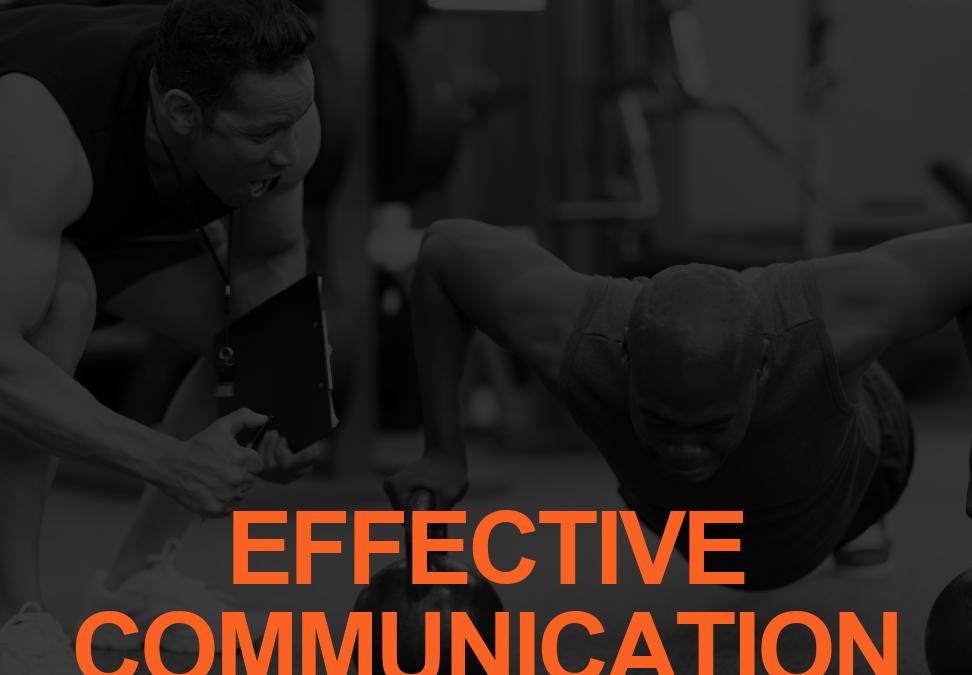Clear, prudent, and relevant communication skills provide clients with the tools needed to overcome adversity, break through a plateau, and feel comfortable turning in a new direction when they fail to meet their goals. A trainer/coach can foster this connection through effective communication, thereby inspiring the client to re-energize even when the going gets tough. Learn how to speak so clients will listen, as well as how to listen when clients speak.
Information Overload
Athletes/clients who believe in their trainers’ instruction, and then see improved performance, tend to engage better in the long run. Science-based training, coupled with observing results and feeling successful, offers proof that good communication skills can work wonders.
One common barrier in communicating effectively consists of giving too many messages/too much information, without allowing sufficient time for a client to process/implement change. Trainers often arrive at a session brimming with information to enhance a client’s lifestyle and workouts. However, if delivered in too much of a rapid-fire mode, the client may feel overwhelmed. Trainers may choose to reserve time at the conclusion of a training session, during which they can quietly share information with clients, and listen to feedback or field questions.
Listening versus Hearing
In order to ascertain clear and effective communication, coaches might periodically ask their clients what they understood, which sometimes varies greatly from the intended message. If a trainer senses that a connection is becoming lost with a client, the client’s performance may concomitantly suffer. Understanding how clients interpret the information offered enables coaches to evaluate the manner of delivery.
As a trainer, remind yourself of the following every time you speak: Will what I am about to say educate, motivate, encourage, benefit and/or protect my client? Am I consistently striving to instill confidence and trust in our working partnership?
The skill of active listening ranks just about as highly as the delivery of information. The sheer act of attentive listening, complete with maintaining eye contact, tends to promote better listening skills in the athlete/client. Frequently responding with relevance helps to promote open and ongoing communication. Trainers might consider keeping an eye on a client’s body language, as such unspoken signals can offer valuable insights as to the manner in which he will best respond to what you say/how you instruct.
Sadly, some clients must experience failure in order for them to start re-engaging. When training groups of athletes/clients encompassing varying levels of athleticism, trainers may need to focus more on those athletes who do listen, since their efforts reflect the help and expertise the trainer strives to impart. While the less compliant/unmotivated clients may temporarily slip through the cracks, they usually return when they find themselves ready to have an open mind.
Setting the Age Stage
Trainers would do well to understand the difference that age can make in a client’s receptiveness, which will ultimately affect progress. Younger athletes respond best to messages directly tailored towards enhancing performance: “What can I do to improve on the field/court/rink/bench press?” These athletes seem willing to go the extra mile, whatever it takes.
Older athletes, however, tend to focus more on recovery and overall health. When working with these clients, grasping the importance of their somatic experience during and immediately following workouts can help the trainer navigate his best mode of instruction. Priorities shift as clients/athletes age, encompassing not only performance but also long-term health and life after stepping back from the competitive arena.
This isn’t always the case, however, and this is where communicating effectively with your clients about their needs and goals is paramount.
Two-Way Effective Communication
For a trainer/client relationship to flourish and maintain longevity, communication operates best as a two-way street. By keeping these lanes open, coaches can cultivate a greater awareness of training opportunities that may have a positive impact on athletes. (However, encouraging two-way communication does not give athletes a free pass to verbally disrespect their trainers.) Nobody likes to hear criticism, even in the form of constructive words sandwiched between praise and accolades. In order for the partnership to grow, trainers might encourage their clients to view workout sessions as a safe place during which to express positive and negative opinions/feelings, with the assurance that the coach/trainer will try his best to remain open-minded and receptive.
Timing Feedback
Effective communication also involves finding the perfect time for delivery of comments, ideally knowing when a client seems most receptive. Some clients respond better to instruction if the coach waits until the conclusion of the game or performance to point out a mistake, whereas another athlete may respond best to immediate correction. In the case of personal training, of course, the trainer must immediately step in if he perceives a significant misalignment in his client’s form, as correcting right there on the spot can thwart a potential injury.
From Stranger to Partner
Personal training involves cultivating a two-way trust with a stranger, understanding emotions, creating vulnerability, and helping him to build the best possible version of himself. Ultimately, this process involves much more than the transformation of his physique. Educate yourself on prudent, effective communication and improved listening. Prove yourself able to support the client through every step of this journey; it can and will make all the difference.
[sc name=”masterfitness” ][/sc]
References:
www.youthenrichmentinsports.org
pure.southwales.ac.uk/ws/portalfiles/portal/5780128/10_Chapter_Manuscript_188_1_10_20210614.pdf
www.psychologytoday.com/us/blog/coaching-and-parenting-young-athletes/202201/communicating-effectively-athletes
www.acsm.org/blog-detail/acsm-certified-blog/2022/04/21/industry-presented-q-a-how-to-effectively-communicate-the-science-behind-performance-with-your-athletes
fitness.edu.au/the-fitness-zone/communication-skills-for-personal-trainers/
Cathleen Kronemer is an NFPT CEC writer and a member of the NFPT Certification Council Board. Cathleen is an AFAA-Certified Group Exercise Instructor, NSCA-Certified Personal Trainer, ACE-Certified Health Coach, former competitive bodybuilder and freelance writer. She is employed at the Jewish Community Center in St. Louis, MO. Cathleen has been involved in the fitness industry for over three decades. Feel free to contact her at trainhard@kronemer.com. She welcomes your feedback and your comments!


